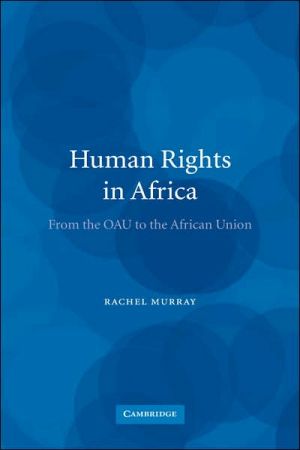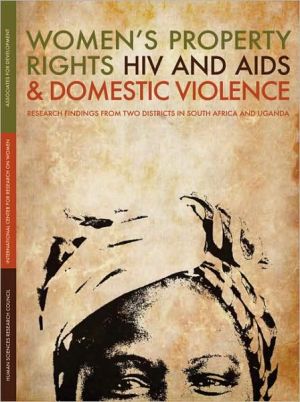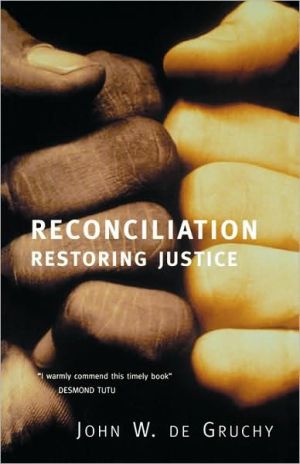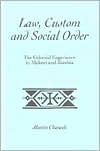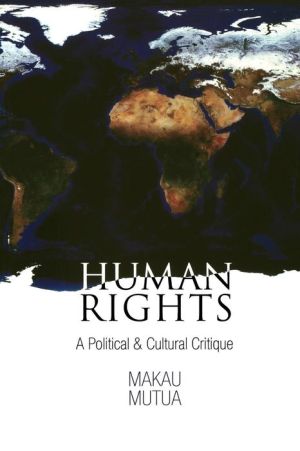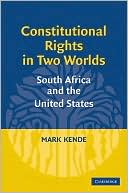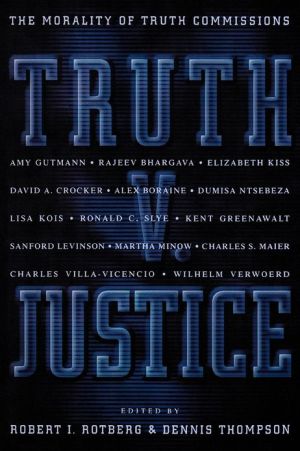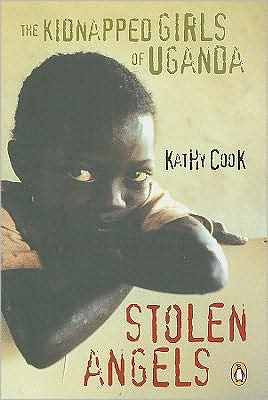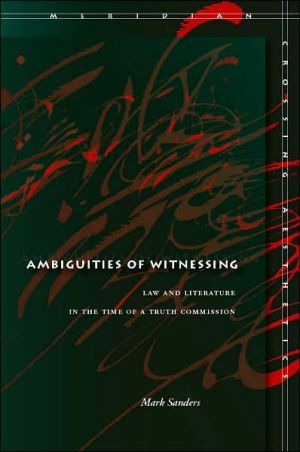Human Rights in Africa: From the OAU to the African Union
This work examines the role of the Organization of African Unity, now the African Union, and how it has dealt with human rights since its inception in 1963. It considers the role of its main institutions both under the OAU and its transformation into the African Union. The book is divided into chapters examining various themes including the rights of women, the rights of the child, the concept of democracy and the right to development. Written by a leading human rights scholar, this book is...
Search in google:
Examines the role of the OAU and how it has dealt with human rights.
\ Cambridge University Press \ 0521839173 - Human Rights in Africa - From the OAU to the African Union - by Rachel Murray \ Excerpt\ \ \ 1\ Historical overview of human rights in the OAU/AU\ \ Introduction\ \ Human rights instruments and the organs that they created were for many years on the periphery of the political institutions under which they fell. This is despite the fact that the manner in which they are formulated and structured requires them to rely on these political institutions for their funding, nominations and appointments to their own organs and in some cases enforcement of their decisions.\ Further, human rights as a discipline has evolved somewhat separately from international law, and international politics has been separated from international law. Thus, human rights have tended to have been dealt with by separate bodies created under the distinct human rights instruments and it is only recently that there has been an increased convergence of human rights into the mainstream of international organisations' thinking. Just as there has been a closer relationship between the European Convention on Human Rights (ECHR) and the European Union (EU),1 so the African political organisation, the Organization of African Unity (OAU), which is now being transformed into the African Union (AU), illustrates this closer attention to human rights as falling within its remit. Whilst a separate instrument was adopted under the auspices of the OAU in 1981 specifically to deal with human rights (the African Charter on Human and Peoples' Rights (ACHPR)), it remained largely on the periphery of the OAU's attention until recently. Yet in later years the OAU organs developed an approach to human rights. This chapter will seek to chart the development of human rights within the OAU/AU from its inception in 1963 to the present day. It will examine the influences on the OAU/AU to deal with human rights and the trends which it has evidenced in selecting on what to focus.\ The creation of the OAU and its structure\ \ Whilst it is not the intention of this book to provide a detailed description of what led to the adoption of the OAU Charter in 1963,2 a sketch of its development is useful. The background to the creation of the OAU can be traced back to a series of developments in various regions across the continent, with the various groupings among French-speaking countries,3 East and Central Africa4 and others pulling in slightly different directions.5 A number of All-African Peoples' Conferences were held in the late 1950s and early 1960s with the aim of encouraging those who were not yet liberated to liberate themselves and to organise non-violent revolution in Africa. Even at this stage the seeds of some human rights issues that would find their way into the OAU can be discerned with condemnation of racism in South Africa, the call for the need for universal vote and concerns about religious separatism, among others.6 States did not, however, agree on the nature of the regional organisation, with some falling into the 'Monrovia' bloc,7 favouring a 'more classical, "confederal" approach where, far from aiming at the integration of African states, sovereignty would be preserved in the framework of a much looser arrangement'.8 In contrast, other states under the leadership of Ghana's President Nkrumah, in what became known as the 'Casablanca' bloc (United Arab Republic, Ghana, Guinea, Mali and Morocco), had signed the more federalist Casablanca Charter for economic cooperation, stressing elements of self-defence and the need to eliminate colonialism.9 In Monrovia in May 1961 a pan-African conference was held in which twenty-two of the twenty-seven states in Africa that were independent at that time participated, although none from the Casablanca bloc. Some liberation movements were also admitted as observers. These states decided what sort of organisation they wanted, as Elias noted:\ The view was unanimous that a loose form of association of independent African states, based upon the principles of economic, cultural, scientific and technical cooperation among its members, was the ideal at which to aim. They one and all disavowed any intention to join any organisation of independent African states that would place the premium on political union supported by a military junta. It was generally felt that economic and technical development . . . should take precedence over political union, at least at this stage of the evolution of the newly independent states.10\ One of the recommendations of the conference was that a Charter should be drawn up for an Organisation of African and Malagasy States.11 Therefore, in January 1962 a second conference of the newly formed Assembly of Heads of States and Government was held in Lagos, Nigeria to look at drafting a Charter. Among other things it proposed the establishment of a Council of Ministers,12 and this organ was mandated to meet in June in Lagos in 1962 to develop the Charter. The text of the Charter was adopted at that meeting and at a further meeting in December of that year seventeen of the twenty-two states signed the Charter of the Organisation of African and Malagasy States, or Lagos Charter.13 A third conference was held in Addis Ababa in Ethiopia. The Council of Ministers prior to that meeting had the task of joining the Casablanca Charter, the Lagos Charter and an Ethiopian draft (similar to the Lagos Charter) together in one document. The result was the Charter of the Organization of African Unity.14 Elias notes that 'the plea of Ghana and of one or two other members for the establishment of a political union of Africa was firmly rejected by the conference'.15 It would thus appear that although the wishes of the Monrovia group dominated, the OAU Charter was 'a product of compromise'.16\ The OAU Charter provided for four principal institutions:17 the Assembly of Heads of State and Government (AHSG), the Council of Ministers, the General Secretariat and the Commission of Mediation, Conciliation and Arbitration. The AHSG was the primary organ with final decision-making powers and the power to review the structure and functioning of the other organs.18 It was composed of heads of state, or their representatives,19 and required to meet at least once a year.20\ The Council of Ministers was composed of the foreign ministers or their representatives and met at least twice a year,21 usually in February and just prior to the Summit of the AHSG in June/July. It was responsible to the AHSG and its task was to prepare these Summits, implement the decisions of the AHSG and coordinate with it.22 Again, as with the AHSG, there was one vote per state, but unlike the AHSG, voting on resolutions only required a simple majority.23 In contrast to the AHSG, despite being 'the most dynamic organ of the OAU', it had limited powers,24 although its role in economic and social matters was often seen as important.25\ The Committee of Ambassadors offered advice to the Council of Ministers and AHSG and decided on issues to go on the agenda of the former. Given that ambassadors were in regular contact with the OAU Secretariat their role in placing human rights on the agenda of the Council of Ministers was crucial. This was particularly the case in respect of the work of the Central Organ on conflict, as Amnesty noted:\ The Ambassadors who are part of the Central Organ form an integral part of the early warning system. During the monthly meetings of the Central Organ of the Conflict Resolution Mechanism, their role should be to assess information on specific human rights situations indicating a possible conflict developing and they should be able to make recommendations to the appropriate organs of the OAU . . . As they are central to the work of the Council, they can influence it to include a consideration of the human rights situation in Africa on the agenda of its meetings. They should include on the agenda of the Council situations where systematic human rights violations provides early warning of a possible conflict.26\ The fourth organ mentioned expressly by the OAU Charter was the Commission of Mediation, Conciliation and Arbitration. The Charter did not define its composition or terms of reference, leaving this to a separate Protocol to be adopted by the AHSG. Although a Protocol was adopted,27 this Commission was never actually established.\ Also provided by the OAU Charter were a number of specialised commissions:28 the Economic and Social Commission;29 the Educational, Scientific, Cultural and Health Commission; and the Defence Commission,30 all of which were composed of the relevant ministers from each state.31 In July 1964 the AHSG also set up a Transport and Communications Commission32 and a Commission of African Jurists.33\ The General Secretariat of the OAU was based in Addis Ababa and was the administrative headquarters of the OAU. It operated under the authority of the Secretary General of the OAU, who was appointed by the AHSG.34 He was supported by Assistant Secretaries.35 The Secretary General and his staff were supposed to be independent of states36 and states themselves were under a duty not to interfere with their mandates.37 The role of the Secretary General in developing a human rights policy of the OAU has gained increasing importance. One of the former Secretary Generals, Dr Salim Ahmed Salim, took a particular interest in human rights concerns.38 His powers have been 'dependent on the Organization's "sovereign" political organs. This limited political role has been partly compensated by a factual development which, over the years, has seen the OAU's Acting President ("Président en exercice") increasingly representing the Organization in relations with third parties.'39\ The General Secretariat was divided into various departments: political; administration and conferences; finance; economic development and co-operation; and education, scientific, cultural and social affairs.40 The Legal Division of the Secretariat provided an overall role and in this respect was crucial in an examination of the approach of the OAU to human rights. However, it is clear that its potential was not fully realised. As Amnesty indicates:\ The role of the Legal Division in regard to human rights issues beyond monitoring of ratifications and drafting of treaties is not very clear but it is understood that it also provides advice to the Secretariat on a range of issues pertaining to human rights including the rights of children and women and contributes to reports of the Secretary General on these issues.41\ With the transformation of the OAU into the AU many of these organs and structures have been replaced or renamed. These will be described further below.\ Human rights within the OAU\ \ The provisions of the OAU Charter make little express mention of human rights. Instead they reflect the dominating concerns of Africa at that time, namely to ensure the independence of those African peoples who were still colonised, condemnation of apartheid regimes in southern Africa, and protecting the newly acquired statehood.42 Thus, its provisions centre on issues such as the non-interference in internal affairs,43 sovereign equality of states,44 the fight against neo-colonialism,45 self-determination in the state context,46 and peaceful settlement of disputes.47 Thus, at this stage, the OAU's focus was on protection of the state, not the individual,48 and any concept of human rights within the OAU went little beyond the notion of self-determination in the context of decolonisation and apartheid in South Africa. As Mathews notes,\ the OAU Charter, for instance, does not contain any provision for the protection of the rights of the African masses . . . evidently the emphasis in 1963 was on the state rather than the people. As President Nyerere of Tanzania, one of the founding fathers of the OAU, has pointed out, the OAU Charter spoke for the African peoples still under colonialism or racial domination, but once the countries emerged to nationhood, the Charter stood for the protection of their heads of state and served as a trade union which protected them. In other words, the OAU appears to be an institution of the African heads of state, by the heads of state and for the heads of state.49\ Thus, where other aspects of human rights are mentioned in the Charter they are broad and general and related to the relationship among states.50 Although there is some note of ethnic divides: 'inspired by a common determination to promote understanding among our peoples . . . in a larger unity transcending ethnic and national differences', this is stressed in respect of African unity as a whole, rather than from the perspective of the impact upon the individual. Further, any threats to human rights appeared to be reflected in the OAU Charter as coming from outside the continent, something which African unity may help to prevent.51 It was clear, therefore, that state sovereignty was sacrosanct.52\ These influences during the 1960s were to define the OAU's approach to human rights issues for many years. Thus, from the point of view of human rights, it was the two issues of self-determination and apartheid/racial discrimination in southern Africa that were central to the OAU at its formation and which appear to have guided its approach to human rights throughout its later years. It is worth paying some attention to them in this respect.\ The concept of self-determination\ \ The history of colonisation to which nearly all of Africa had been subject, the resulting groupings among newly independent African states and the idea of a sense of African unity53 were behind the creation of the OAU.54 Indeed, it has been said that 'the Charter of the OAU is more than the constitution of an African regional organisation: it is a charter of liberation'.55 This was reflected in the preamble of the OAU Charter which sought, as Naldi notes,\ to preclude external intervention in African affairs. This aim is linked to the goal of eradicating all forms of colonialism and neo-colonialism from Africa . . . This was a reference not only to the racist regimes of Southern Africa . . . but also to the policies by which external powers indirectly maintained or extended their influence over African countries. The eradication of colonialism in all its forms was therefore regarded as a necessary prerequisite to the attainment of the OAU's goals.56\ The OAU spent many of its early years assisting in the liberation of colonised entities and giving assistance to liberation movements,57 including funding their arms purchases and providing them with training.58 Thus, the OAU would appear to have supported the notion that there was a legal duty on states to end colonialism59 and 'armed struggle has proven to be . . . a legitimate method of asserting the right of self-determination of a colonial or oppressed people'.60 This anti-colonialism stance is reflected in the main human rights treaty for Africa, Article 20(2) ACHPR, which suggests that those under foreign domination can use any means to be free from it. This was supporting the notion that 'once people are recognised as having a right of self-determination, it follows logically and inevitably that they must also be legally entitled to resist any action aimed at denying them that right'.61\ Resolutions were adopted on decolonisation62 and the OAU created a Liberation Committee.63 Despite some difficulties,64 'the OAU as a whole remained loyal to its self-assigned task of helping the people of the colonised territories of Africa to fight for their independence',65 the Liberation Committee meeting regularly and ensuring that the issue was maintained on the agenda of the UN and OAU organs. Its recognition of liberation movements assisted in their obtaining assistance from other countries and access to the OAU and UN meetings and contributed towards defining what amounted to a liberation struggle66 and setting out other standards for liberation movements. The southern Africa issue was at the forefront of such discussions.\ \ \ \ \ © Cambridge University Press
1Historical overview of human rights in the OAU/AU12The relationship between the OAU/AU and the African Commission on Human and Peoples' Rights493The link between human rights and democracy734The relationship between conflict and human rights1165Women and the OAU/AU1346Children's rights in the OAU/AU1637Refugees and human rights1858Development, NEPAD and human rights2359Conclusion267App. ICharter of the Organization of African Unity271App. IIConstitutive Act of the African Union280App. IIIAfrican Charter on Human and Peoples' Rights294
